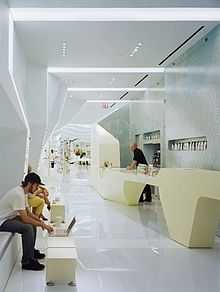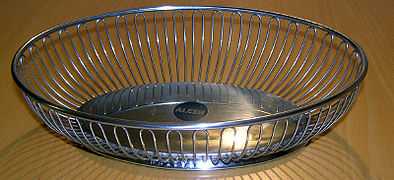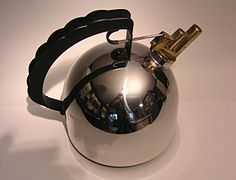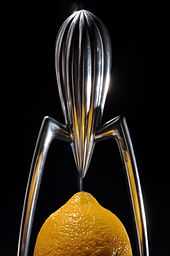Alessi (Italian company)

Alessi is a housewares and kitchen utensil company from Italy. They make everyday items from plastic and metal, designed by famous designers.
From the 1980s onward, Alessi has been particularly associated with the notion of "designer" objects - otherwise ordinary tools and objects executed as high design, particularly in a post-modern mode, from designers such as Philippe Starck. Many of the early memorable "designer kettles", "designer toothbrushes", "designer kitchenware" and so on were Alessi products, though competition in this product category has greatly increased since then.
History

1920s to 1940s
Alessi was founded in 1921 by Giovanni Alessi. The firm began as a workshop in Valle Strona near Lake Orta in the Italian Alps near Switzerland. An area known for its tradition in making small objects of wood or metal for in the house and in the kitchen in general. Alessi started with producing a wide range of tableware items in nickel, chromium and silver-plated brass. The company’s intention was to produce hand-crafted items with the aid of machines. Design in the current sense of the term began when Carlo Alessi (born 1916), son of Giovanni, was named chief designer. Carlo was trained as an industrial designer. Between 1935 and 1945 he developed virtually all of the products Alessi produced. In 1945 he ascended to chief executive and designed the coffee service.
1950s and 1960s
In the 1950s the company was under the leadership of Carlo Alessi.[1] It was his brother Ettore Alessi who introduced the collaboration with external designers in 1955. With some architects, he designed a number of items which were created for the hotel needs. Through his intervention caused many individual objects, which were best-sellers, such as the historical series of wire baskets. One of the key designs of this period is the shaker from 1957 by Luigi Massoni and Carlo Mazzeri. This was designed in a series with an Ice bucket and Ice tongs as part of the Program 4 for the 11 triennale in Milan.[2] This was the first time that the Alessi products got shown with manufactured goods. 1950s would also of been a hard time for them to sell there designer objects as it has only been 5 years past the world war so a lot of people don't have much expendable income to spend on designer objects.
1970s and 1980s
In 1970 Alberto Alessi was responsible for the third transformation of the company. Alessi was considered one of the "Italian Design Factories". In this decade under the leadership of Alberto Alessi the company collaborated with some design maestros like Achille Castiglioni, Richard Sapper, Alessandro Mendini and Ettore Sottsass, who are now all icons of the 1970s. In the '70s Alessi produced the Condiment set (salt, pepper and toothpicks) by Ettore Sottsass, the Espressomaker by Sapper.
The 1980s marked a period in which Italian Design Factories had to compete with mass production. These movements had a different view on design, for the Italian Design Factories the design and therefore the designer was the most important part of the process while for the mass production the design had to be functional and easy to be reproduced.[3] Also in the 1980s they changed their ideology from factory to industrial research lab, meaning that it is a place for research and production. For Alessi the '80s are marked with some iconic designs like the two tone kettle by Sapper, their first cutlery set Dry by Castiglioni. Alessi collaborated with new designers like Aldo Rossi, Michael Graves and Philippe Starck who have been responsible for the some of Alessi's all time bestseller like the kettle with a bird whistle by Graves.
1990s to the present
In recent decades as the "designer houseware" market greatly expanded, Alessi faced increasing competition from other international manufacturers, especially in lower-cost products mass-produced for retailers such as Target Corporation and J. C. Penney.
In the 1990s Alessi started to work more with plastic, at the request of designers who found it an easier material to work with than metal, offering more design freedom and innovative possibilities. The 1990s were marked by the theme Family Follows Fiction with playful and imaginative objects. Artists designing for this theme included Stefano Giovannoni and Alessandro Mendini, who designed Fruit Mama and the bestseller Anna G. Metal still remained a popular material, for example the Girotondo family by King Kong.
During the 2000s Alessi collaborated with several architects for the coffee and tea towers, with a new generation of architects such as Wiel Arets, Zaha Hadid, Toyo Ito, Tom Kovac, Greg Lynn, MVRDV, Jean Nouvel, and UN Studio. These sets had a limited production of 99 copies. Another remarkable design in the 2000s is the Blow Up series by Fratelli Campana. The brothers played with form and shape to create baskets and other objects that look like they would fall apart when touched.
In 2006, the company reclassified its products under three lines: A di Alessi, Alessi and Officina Alessi. A di Alessi is more ‘democratic’ and more ‘pop’. This product line is the lower price range of Alessi. Alessi is the historic brand company and continues to develop the best of industrial mass production industry from the view of quality and design in a medium/high price range. The Officina Alessi is more exclusive, innovative and experimental, this is marked by small batch production series and limited series.
Alessi products are on display in museums worldwide like Museum of Modern Art New York, Metropolitan Museum of Art, Victoria and Albert Museum, Pompidou Centre and Stedelijk Museum Italy.
Designers and their designs
From 1945 until today Alessi has collaborated with designers and even other brands or companies for their products. Some key designs and their designers:
- 1945: Bombé by Carlo Alessi Anghini
- 1978 Condiment set (salt, pepper and toothpicks) by Ettore Sottsass
- 1980 9090 caffettiera by Richard Sapper
- 1982 Dry by Achille Castiglioni the first cutlery produced by Alessi
- 1983 whistling water kettle Bollitore by Richard Sapper. Alessi’s first "designer kettle", with a whistle whose pipe sings two tones, miand si, giving an attractive harmony.
- 1984 La Conica by Aldo Rossi. This was Rossi’s first mass-production design and its strongly iconic image earned immediate success for the then-new Officina Alessi brand, as well as becoming an 1980s design symbol. Therefore it was soon to be followed by more Rossi designs in this theme.
- 1985 Kettle by Michael Graves. This iconic kettle is known for its singing bird when the water boils. Followed by matching products like a sugar bowl and a creamer, also designed by Graves. This is actually the product that has sold the greatest number of units in the history of the company.
- 1990 Juicy Salif by Philippe Starck is a truly iconic object which is not only a symbol for Starck but also for Alessi itself. It’s revolutionary design is not only functional but also nice to look at.
- 1989 Girotondo family by King-Kong
- 1993 Fruit mama by Stefano Giovannoni. The first design for the Family Follows Fiction series
- 1994 Anna G corkscrew by Alessandro Mendini. A best seller since it was first produced. Her smiling face has become a cult firugre over the years and is accompanied by a rich family of object for the table and kitchen
- 1995 Mary Biscuit by Stefano Giovannoni. The biscuit container with a lid that smells like a biscuit.
- 1997 Nono di Antonio garlic crusher by Guido Venturini
- 2004 Blow Up citrus basket by Fratelli Campana
- 2006 Kaj watch by Karim Rashid
- 2013 Dressed by Marcel Wanders
Another notable collection is the collaboration with the National Palace Museum of Taiwan, a collection of various kitchenware products with Asian themes.
-

Oval breadbasket, 1955
-

Sapper kettle, 1983
-
Graves tea service, 1983
-

Graves kettle, 1984
-

Starck "Juicy Salif" juicer
See also
References
- ↑ Chief executive
- ↑ Alberto Alessi, The Dream Factory. Alessi since 1921, Milan 1998 pp. 16-18.
- ↑ http://www.youtube.com/watch?v=PgslDPwig7s
